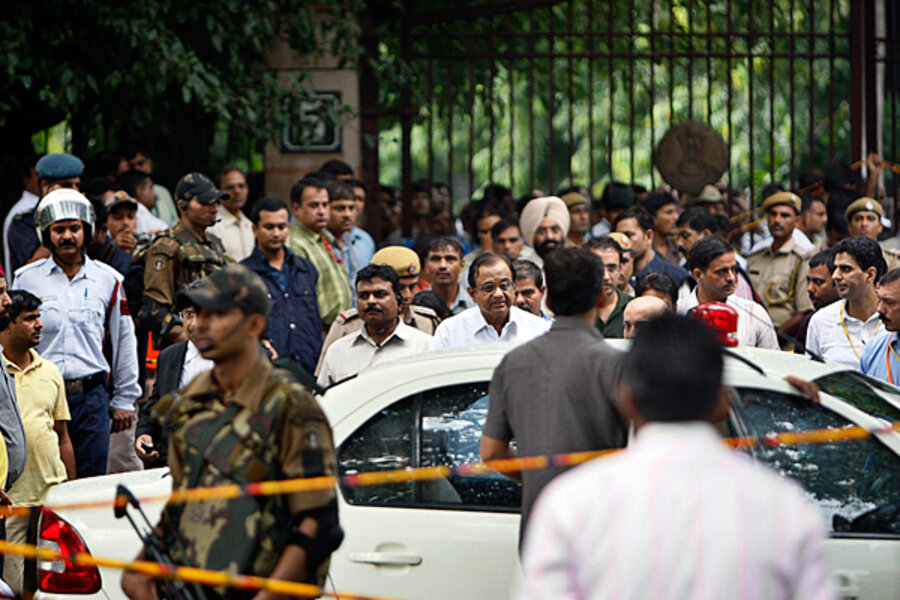Delhi High Court bombing is latest in a string of major attacks
Loading...
| New Delhi
A bomb exploded at a crowded entrance to the Delhi High Court this morning, killing at least 11 people, injuring some 60, and adding to a string of recent terror attacks in India.
The bomb ripped through a congested area where litigants waited to pick up entrance passes to the court. A blast struck this same court in May. While security was beefed up in response to the earlier attack, no metal detectors were set up near the area where passes are distributed, say lawyers on the scene.
“The people collect there, and there is always a crowd,” says lawyer Vivek Kumar. He described the scene that morning saying: “I felt the tremors [from the bomb]. I saw dust blowing. I saw people running.”
India is wracking up a long list of unresolved terror cases. And it’s not because of a lack of metal detectors or security cameras, but rather a shortage of human intelligence gathering, argue counterterrorism experts.
“The investigating agencies and intelligence agencies and the police have been having difficulties. There has been no successful investigation since the Nov. 26 [2008 Mumbai attacks],” says B. Raman, former head of counterterrorism for India’s spy agency. “It’s not just due to deficiencies in equipment, it’s deficiencies in the human element.”
The militant group Harkat-ul-Jihad-al-Islami (HUJI) claimed responsibility for the bombing, according to an e-mail received by some Indian media. HUJI has been active in Pakistan, India, as well as Bangladesh, where the Indian Prime Minister is visiting. A US-drone strike reportedly killed one of HUJI’s top commanders, Ilyas Kashmiri, in June. Indian investigators have said they are looking at the e-mail but it’s too early to name any suspects.
Over the past year alone, several high-profile attacks remain unresolved, including the Mumbai blasts in July, the Delhi High Court bomb in May, and a bombing in Varanasi. Go back a few years, and the list just in Delhi grows longer, including market blasts in 2005, mosque bombings at Jama Masjid in 2006 and 2010, and a 2008 explosion at a Mehrauli market.
“In a country of a billion-plus people adding a detector doesn’t help,” says Shishir Gupta, deputy executive editor of the Hindustan Times who penned a critical op-ed on India’s counterterrorism deficiencies that ran just before this morning’s blast.
At the time of the Jama Masjid attack in 2010, the mosque had dozens of security cameras on the walls, he says. “Not even a single silly one was working. You need to build up a capability where you neutralize these guys much before these blasts take place,” says Mr. Gupta. And the CCTV footage of July's Mumbai attacks was too pixilated to be of much use there, either.
He points to a recent success story where detectives on the ground thwarted a plot to assassinate three judges. An antiterror unit in Madhya Pradesh decided to round up the remnants of a terror group called the Students Islamic Movement of India (SIMI). SIMI overlaps significantly with another domestic group called the Indian Mujahideen (IM), which authorities suspect in several unsolved cases such as the Mumbai blasts in July and the Delhi court bomb in May.
For each known SIMI member, the Madhya Pradesh antiterror unit assigned two or three detectives to hunt him down. One such search team found their man. His interrogation broke open the plot against the judges who had issued a verdict in the controversial Ayodhya case where Hindus and Muslims both claim a holy site.
Catching the men any other way would have been difficult, says Gupta, who is also author of “Indian Mujahideen: The Enemy Within.” Groups like SIMI and IM now avoid cellphones in favor of untraceable Internet communications. The would-be assassins in this case failed to get financial help abroad so started kidnapping to raise money themselves.
“They operate in small cells which are self-contained, self-financed, self-helped,” says Gupta. Tackling these cells requires more cops on the beat. “You need the beat constable who is walking around and finding out what’s going wrong in his vicinity.”





